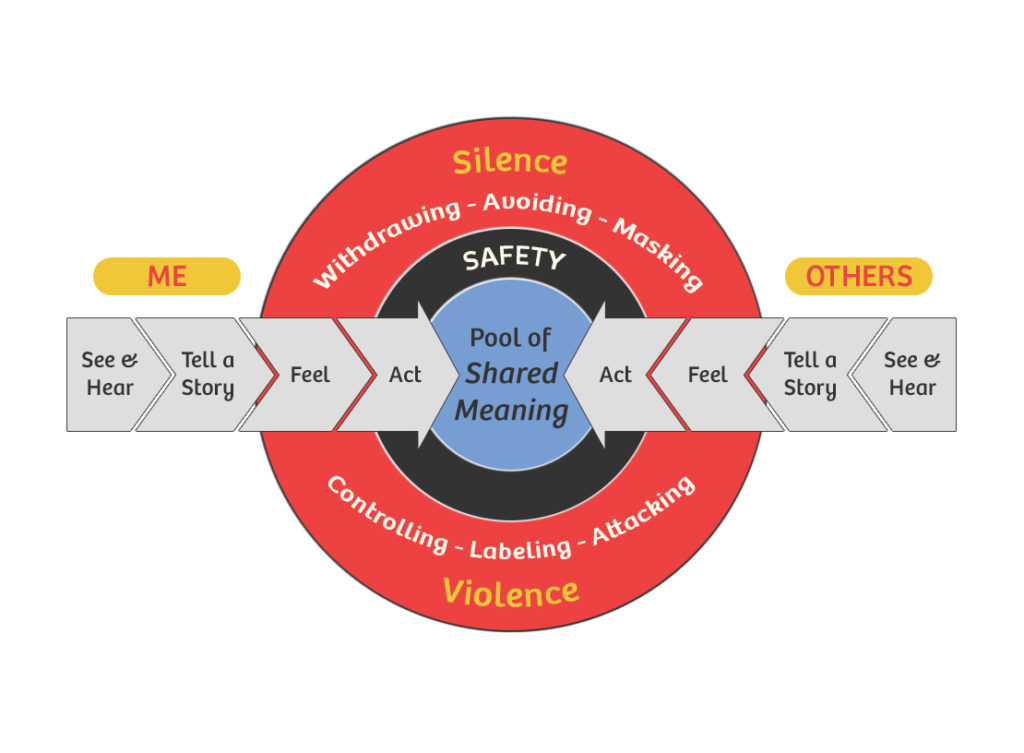What It Is:
The Dialogue model is a key component of the “Crucial Conversations” methodology developed by Kerry Patterson, Joseph Grenny, Ron McMillan, and Al Switzler. Crucial Conversations is a framework and set of skills aimed at addressing high-stakes and emotionally charged conversations in a productive manner. The Dialogue model provides a structure for engaging in effective and open communication, especially during crucial conversations.
Origin of Crucial Conversations and the Dialogue model: The concept of Crucial Conversations and the associated Dialogue model was introduced in the book “Crucial Conversations: Tools for Talking When Stakes Are High,” first published in 2002. The authors, Kerry Patterson, Joseph Grenny, Ron McMillan, and Al Switzler, are co-founders of VitalSmarts, a corporate training and organizational performance company.
Dialogue model from Crucial Conversations: The Dialogue model consists of three components:
- Description:
- Start by describing the facts of the situation objectively. Stick to observable behaviors and avoid interpreting or adding judgments. This sets the foundation for a shared understanding of what happened.
- Feelings:
- Share your feelings about the situation, using “I” statements to express your emotions. It’s important to be honest and open about your emotional response, fostering an environment where others feel comfortable doing the same.
- Identity:
- Discuss the impact of the situation on your identity and the identity of others involved. This involves exploring the personal significance and potential threats to one’s self-worth. It’s crucial to create a safe space for individuals to express their concerns without fear of judgment.
How to Use It:
Using Dialogue model in Agile Coaching:
- Retrospectives:
- Apply the Dialogue model during retrospectives to facilitate open and honest discussions about team dynamics, challenges, and successes. Encourage team members to describe observable behaviors, express their feelings, and discuss the impact on their identity.
- Conflict Resolution:
- When conflicts arise within the team, use the Dialogue model to guide conversations toward resolution. Encourage team members to describe the specific issues, express their feelings about the conflict, and explore the impact on their identity and relationships.
- Feedback Sessions:
- Incorporate the Dialogue model into feedback sessions. Provide a structure for individuals to share feedback in a constructive manner, focusing on observations, emotions, and identity impact.
- Agile Ceremonies:
- Integrate the Dialogue model into various Agile ceremonies such as sprint reviews, sprint planning, and daily stand-ups. Encourage team members to communicate openly about their observations, feelings, and the impact of their work on the team’s identity.
Implementing the Dialogue model in Agile coaching fosters an environment of open communication, transparency, and trust within the team. It enables team members to address crucial conversations effectively, leading to improved collaboration and productivity.
References:
Resources on Dialogue model from Crucial Conversations:
- “Crucial Conversations: Tools for Talking When Stakes Are High” by Kerry Patterson, Joseph Grenny, Ron McMillan, and Al Switzler:
- The book serves as the primary resource for understanding the Dialogue model and Crucial Conversations methodology. It provides practical tools and techniques for effective communication in high-stakes situations.
- Crucial Conversations Training Programs:
- Explore training programs and workshops offered by VitalSmarts, the organization founded by the authors. These programs often provide in-depth training on the Dialogue model and Crucial Conversations skills.
- Online Resources:
- Visit the official Crucial Conversations website and other online platforms for articles, videos, and additional resources related to the Dialogue model. These resources can offer ongoing support and insights.
Visit the Agile Coach’s Toolkit for more definitions, models, theorems and stuff.

